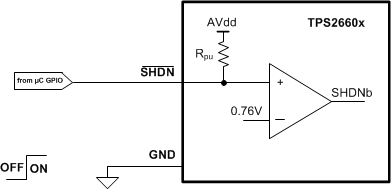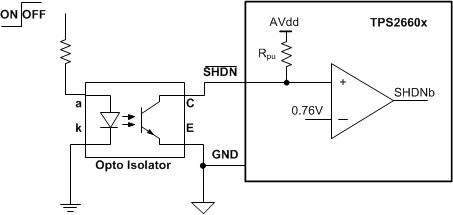SLVSDG2G July 2016 – December 2019 TPS2660
PRODUCTION DATA.
- 1 Features
- 2 Applications
- 3 Description
- 4 Revision History
- 5 Device Comparison Table
- 6 Pin Configuration and Functions
- 7 Specifications
- 8 Parameter Measurement Information
-
9 Detailed Description
- 9.1 Overview
- 9.2 Functional Block Diagram
- 9.3
Feature Description
- 9.3.1 Undervoltage Lockout (UVLO)
- 9.3.2 Overvoltage Protection (OVP)
- 9.3.3 Reverse Input Supply Protection
- 9.3.4 Hot Plug-In and In-Rush Current Control
- 9.3.5 Overload and Short Circuit Protection
- 9.4 Device Functional Modes
-
10Application and Implementation
- 10.1 Application Information
- 10.2
Typical Application
- 10.2.1 Design Requirements
- 10.2.2 Detailed Design Procedure
- 10.2.3 Application Curves
- 10.3 System Examples
- 10.4 Do's and Don'ts
- 11Power Supply Recommendations
- 12Layout
- 13Device and Documentation Support
- 14Mechanical, Packaging, and Orderable Information
- 14Mechanical, Packaging, and Orderable Information
Package Options
Refer to the PDF data sheet for device specific package drawings
Mechanical Data (Package|Pins)
- RHF|24
- PWP|16
Thermal pad, mechanical data (Package|Pins)
- PWP|16
Orderable Information
9.3.5.7 Low Current Shutdown Control (SHDN)
The internal FETs and hence the load current can be switched off by pulling the SHDN pin below 0.76 V threshold with a micro-controller GPIO pin or can be controlled remotely with an opto-isolator device as shown in Figure 48 and Figure 49. The device quiescent current reduces to 20 μA (typical) in shutdown state. To assert SHDN low, the pull down must sink at least 10 µA at 400 mV. To enable the device, SHDN must be pulled up to atleast 1 V. Once the device is enabled, the internal FETs turnon with dVdT mode.
 Figure 48. Shutdown Control
Figure 48. Shutdown Control  Figure 49. Opto-Isolator Shutdown Control
Figure 49. Opto-Isolator Shutdown Control